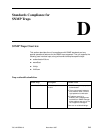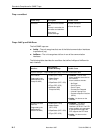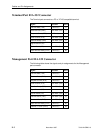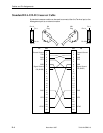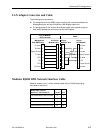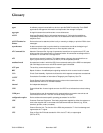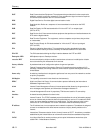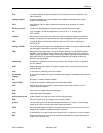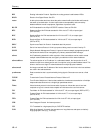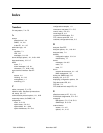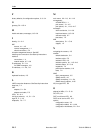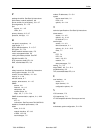
Glossary
GL-3
7610-A2-GB20-10
November 1997
Local Area Network. A network designed to connect devices over short distances, like
within a building.
A latching loopback can only be initiated or terminated by the 64 kbps clear channel
network service provider.
Light Emitting Diode. A status indicator that responds to the presence of a certain
conditions.
The protocol that regulates the communication between two network nodes.
Local Loopback. An EIA-lead standard for V.24 circuit CT 141; an input signal
(DTE-to-DCE).
Used to test various portions of a data link in order to isolate an equipment or data line
problem. A diagnostic procedure that sends a test message back to its origination point.
Line Signal Detect. An EIA-lead standard for V.24 circuit CT 109; an output signal
(DCE-to-DTE).
The device that queries agents for management information, or receives unsolicited SNMP
trap messages indicating the occurrence of specific events.
Management Information Base. The set of variables a device running SNMP maintains.
Standard, minimal MIBs have been defined, and vendors often have private enterprise
MIBs. In theory, any SNMP manager can talk to any SNMP agent with a properly defined
MIB. MIB-II refers to an extended management database that contains variables not
defined in the original MIB I.
A method for interleaving several access channels onto a single circuit for transmission
over the network.
Network Management System. A computer system used for monitoring and controlling
network devices.
A connection or switching point on the network.
A non-latching loopback can only be initiated or terminated by the 56 kbps network service
provider.
No Signal. A network-reported condition.
A specific item within the Management Information Base (MIB).
Out Of Frame. An error condition in which frame synchronization bits are in error. A
network-reported condition.
Out of Service. A digital network trouble signal.
Packet Assembler/Diassembler.
A data network circuit with one control and one tributary device.
Point-to-Point Protocol. A link-layer protocol used by SNMP.
The rules that govern how devices exchange information on a network. It covers timing,
format, error control, and flow control during data transmission.
Public Switched Telephone Network. A network shared among many users who can use
telephones to establish connections between two points.
A reinitialization of the device that occurs at power-up or in response to a reset command.
Request for Comments. The set of documents that describes the standard specifications
for the TCP/IP protocol suite.
LAN
latching loopback
LED
link layer protocol
LL
loopback
LSD
manager (SNMP)
MIB
multiplexing
NMS
node
non-latching
loopback
NS
object (SNMP)
OOF
OOS
PAD
point-to-point circuit
PPP
protocol
PSTN
reset
RFC



